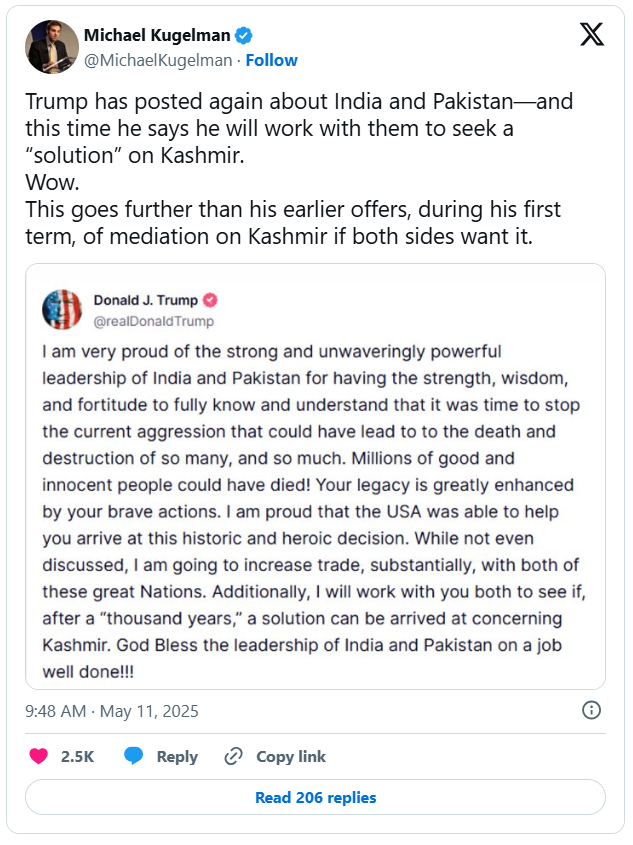Welcome to The India Fix by Shoaib Daniyal. A newsletter on Indian politics.
As always, if you’ve been sent this newsletter and like it, to get it in your inbox every week, sign up here (click on “follow”).
At 5.25 pm on Saturday, the President of the United States posted a message on social media that brought relief to nearly two billion people. “After a long night of talks mediated by the United States, I am pleased to announce that India and Pakistan have agreed to a FULL AND IMMEDIATE CEASEFIRE,” he said (caps are Trump’s, not mine).
It was only half an hour later that the government of India actually announced a ceasefire. “Both sides would stop all firing and military action on land, air and sea at 5 pm,” said Foreign Secretary Vikram Misri in a press briefing that lasted less than a minute.

Why did another country announce that India’s armed forces are going to stop hostilities with Pakistan in the wake of the Pahalgam terror attack? And what does that politically mean for Modi’s strongman image?
Made in America
The answer to the first question is simple: the US is claiming credit for brokering peace between the subcontinental twins. In fact, the US state department has put out a statement calling this a “US-Brokered Ceasefire between India and Pakistan”.
CNN has reported that the US received “alarming intelligence” on Friday that could lead to a “dramatic escalation”. The US Vice President then called Modi urging him to talk to Pakistan and “to consider options for de-escalation”. This was the “critical moment” that got India and Pakistan moving towards a ceasefire, according to CNN.
India’s long-held position has always been that its conflict with Pakistan is a bilateral matter and it does not want any mediation. Unsurprisingly, the Modi government has rushed to firefight these US statements, putting a flurry of anonymous quotes in the media denying that the US had any role to play.

Even worse, the US’ statements seem to suggest that it thinks Kashmir is back as an issue internationally. On Sunday, Trump put out another statement offering to mediate so that a “solution can be arrived at concerning Kashmir”. Before that Secretary of State Marco Rubio claimed that India and Pakistan had agreed to “start talks on a broad set of issues at a neutral site,” contradicting Delhi’s position that it will not talk till Islamabad abjures terror.

Strong, man?
India’s ideal war aim, as it bombed Pakistan on May 7, was to make the country bend completely. “India seeks for Pakistan to have an embarrassing defeat,” said Christopher Clary, a US academic and an expert on South Asia’s security politics.
However, rather than a Pakistani military surrender as India achieved in 1971 when Indira Gandhi was prime minister, what Modi has managed to pull off is a ceasefire. The absence of a surrender is risky for Modi's strongman image. That the US is now claiming that it brokered the ceasefire is doubly so.
Notably, Modi has long attacked the Congress as being weak for reaching out to the US. “Our minister went to America and started crying ‘Obama, Obama’,” Modi had said in a viral interview from when he was Gujarat chief minister, making mock actions of tears.
Will the Congress now be able to politicise this in the same way, attacking Modi’s as being weak for Trump’s claims of mediation?

What happens now?
The other risk for Modi is if Pakistan decides to continue its policy of supporting terror. Like the ceasefire after India’s and Pakistan’s tit-for-tat airstrikes in 2019, the current detente is premised on allowing both sides to go to their people and claim a Potemkin victory. However, 2019 is a poor template for Delhi: if India hoped that airstrikes would dissuade Pakistan from backing terror, that is clearly not the case, given the horror in Pahalgam.
Will the 2025 hostilities persuade Pakistan to end its support to terror if 2019 didn’t? There are already prominent voices of scepticism asking what India achieved by Operation Sindoor, given the ceasefire only three days later.
“We have left India’s future history to ask what politico-strategic advantages, if any, were gained after its kinetic and non-kinetic actions post Pakistani horrific terror strike in Pahalgam on 22 April,” former Indian Army chief Ved Malik posted on social media.
Even as journalists and analysts unpack the political losses and gains for individual players and states, one thing is certain: the people of South Asia simply cannot afford conflict. Both India and Pakistan are poor countries with large populations and nuclear weapons. War is simply not an option. A ceasefire is great news. Now we only need to hope that it sticks.










